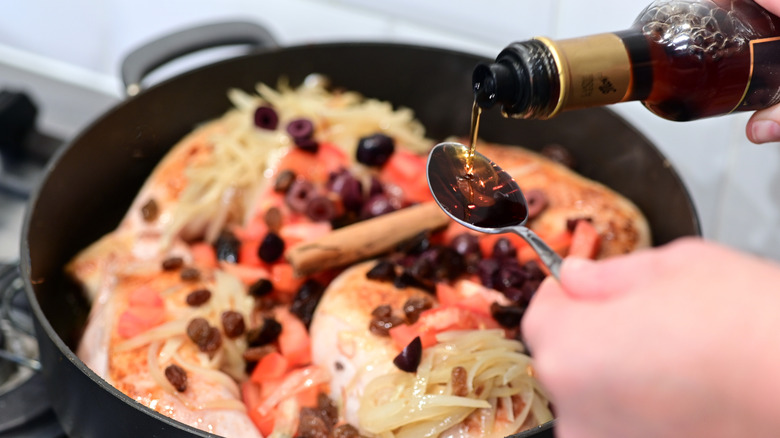The Cheap Vinegar You Should Keep In Your Pantry For A Flavorful Drizzle
A little vinegar goes a long way when it comes to enhancing food, adding both brightness and balance. Adding this acidic ingredient is a game changer for soups, salads, grilled meats, and all kinds of other dishes. But if you tend to rely on the usual suspects — balsamic, cider, or wine vinegar — then you're missing out on a particularly fine and flavorful example: sherry vinegar. It adds a delicious depth and complexity to your cooking and is often less expensive than balsamic vinegar (especially the real stuff).
Commonly used in Spanish cookery, sherry vinegar is revered for its nutty, caramel-like notes, and unlike some other vinegars, it is neither too sweet nor overly acidic. Known as vinagre de Jerez, authentic sherry vinegar is made in the Cádiz region in southern Spain. It is aged in oak barrels for at least six months, but often longer, which intensifies the flavor. The term "reserva" on the label denotes a minimum of two years of aging, while "gran reserva" means it has aged for a decade or more.
The taste of the vinegar also depends on the grapes used to make it. Palomino grapes give a lighter and crisper finish, and this is the type of vinegar you'll see most commonly. Vinegars made from Pedro Ximenez and moscatel grapes tend to be sweeter and more aromatic. The layers of complex flavors make sherry vinegar a truly versatile addition to your culinary arsenal. While it is a key component in gazpacho (which is not just cold tomato soup), it also makes a fantastic addition to a variety of recipes.
How to use sherry vinegar in different ways
Besides gazpacho, adding a few drops of sherry vinegar can elevate many other soups, too. It's a star ingredient in sopa de ajo y vinagre (Spanish-style garlic and vinegar soup), balancing the sweet and smoky paprika, pungent garlic, and fresh, grassy parsley. But it also brightens rich three-ingredient tomato soup and works beautifully with root vegetable-based broths. Try adding a splash to a creamy, earthy mushroom soup at the end of the cooking process. In fact, a little drizzle is a great way to finish pretty much any soup before serving.
Sherry vinegar is the perfect partner for tomato sauces as well — simply stir it in once it's finished simmering. Or use it in a vinaigrette dressing to amp up the umami-rich flavor of raw tomatoes. Whisk the vinegar, plus your preferred seasonings, with extra virgin olive oil or sesame oil to complement its natural nuttiness. It's an easy way to improve upon something as perfect as caprese salad, and it goes great with most leafy green salads, too.
You can also use sherry vinegar to boost the flavor of sauces for grilled meat, fish, or vegetable dishes. Reduce it with chicken broth, garlic, paprika, and honey for a rich sauce for chicken, or add it to beef stock, garlic, shallots, and sweet madeira for a robustly flavored sauce to serve with steak. Mixing equal amounts of sherry vinegar with brown sugar and a little water gives a great glaze for salmon, or toss roasted vegetables in sherry vinegar, butter, and mustard for a tasty finish.

